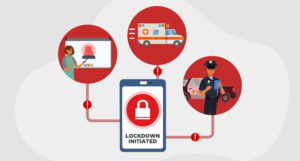Summer is the ideal time for districts to review and update essential plans, policies, and procedures. These steps are critical to ensuring schools operate safely, efficiently, and in compliance with requirements.
During this process, schools should focus on seven key areas. From refining school safety plans to adopting specific lockout/tagout procedures, these efforts contribute to creating a secure and effective learning environment for students, staff, and the community.
1. School Safety Plan:
A school safety plan serves as the backbone of a well-prepared school. Most states currently mandate schools to develop comprehensive safety or emergency response plans. These plans often include:
- Threat assessment and response protocols
- Emergency response procedures
- Evacuation strategies
- Communication systems for emergencies
Districts should begin by assessing the current safety plan to ensure it aligns with best practices and complies with state and local regulations. Collaboration with staff, students, parents, and community members can provide valuable perspectives and identify improvement opportunities.
The U.S. Department of Education’s Schoolsafety.gov platform offers a Safety Readiness Tool. This tool covers critical topics to evaluate, including:
- Designated safety personnel
- School climate
- Threat reporting systems
- Emergency operation plans
- Site security assessments
- Faculty and staff training programs
Consider incorporating lessons learned from recent incidents or drills and explore emerging technologies that can enhance safety measures. Regularly update and communicate the safety plan to ensure all members of the school community are aware of their roles and responsibilities during emergencies.
2. Lockout Tagout (LOTO) Procedures:
Lockout tagout procedures are essential to protect staff and students from hazardous energy sources in equipment and machinery. Schools should regularly review and update these procedures to maintain a safe educational environment.
An effective lockout tagout program should include:
- Identification of all powered machinery in school buildings
- Documentation of all energy sources within school facilities
- Listing of energy-isolation devices, such as switch panels
- Identification of employees who operate or service powered equipment
- Detailed procedures for shutting down, locking/tagging out, and restarting machinery
- Comprehensive staff training on lockout tagout protocols
Districts should also conduct regular maintenance, inspections, and audits of equipment to ensure ongoing compliance. Fostering a safety-oriented culture among staff reinforces awareness and accountability, risks.
Raptor Staff Compliance Training—powered by PublicSchoolWORKS— offers three OSHA/CalOSHA compliant LOTO courses, as well as a full catalog of OSHA/Occupational Safety courses:
- Lockout / Tagout (Authorized Employees) (45 minutes)
- Lockout / Tagout Awareness (15 minutes)
- Lockout / Tagout (CalOSHA) (20 minutes)
Check out the course catalog and filter to ‘OSHA/Occupational Safety’.
3. School Wellbeing Policy:
A robust school wellness policy plays a crucial role in promoting the health and wellbeing of students, staff, and the entire school community. The Centers for Disease Control and Prevention (CDC) released their report “Poor Mental Health Effects Adolescent Well-being” for 2013-2023, highlighting that:
- Overall mental health emergencies had dropped 11%
- Attempted suicides and similar behaviors fell 12%
- Teens also had fewer hospital visits related to anxiety, depression or attention disorders in 2022
“The CDC credited improvements in mental health in part to schools’ widescale increases in mental health supports, from providing more access to therapists and social workers, to teacher training to support students with anxiety.”
Although the data is trending in the right direction, teen mental health is still a public health crisis. Districts should review their existing wellness policy annually to assess its effectiveness in addressing nutrition, physical activity, identifying students struggling with mental health, mental health support, and overall wellness.
Districts should annually assess their wellness policy for effectiveness in promoting nutrition, physical activity, mental health support, and overall well-being.
Strategies for an updated wellness policy include:
- Engaging stakeholders like students, parents, and health professionals during policy reviews
- Incorporating evidence-based approaches to nutrition and fitness programs
- Partnering with local health agencies and community organizations to provide resources
- Regularly evaluating mental health support systems and related initiatives
- Leveraging tools for identifying and documenting low-level concerns to help students get the supports they need sooner.
Updating the policy and training staff on best practices ensures the district meets community needs effectively.
4. District Training Plan:
A well-structured district training plan equips staff with the knowledge required to perform their responsibilities safely and effectively. Although not mandated in all areas, a written training plan helps districts meet state and federal requirements while addressing specific challenges related to education.
When reviewing your training plan, consider:
- Evaluating current training offerings to identify gaps or shortcomings
- Tracking annual completion rates to ensure compliance with required standards
- Offering flexible, accessible online training modules
- Developing role-based training plans for staff, including administrators, teachers, and support personnel
Continually updating the training plan helps address emerging priorities and integrates modern training methods that meet the diverse needs of school staff.
5. Bloodborne Pathogens Program:
Protecting staff and students from bloodborne pathogens is of utmost importance in a school setting. The U.S. Department of Education shares that “OSHA issued the Occupational Exposure to Bloodborne Pathogens Standard Regulation to reduce or eliminate the possibility of an employee contracting any of a series of diseases that are spread through blood or other potentially infectious materials.”
“The Bloodborne Pathogens Standard requires covered employers to do the following:
- Write an exposure control plan to determine how exposure to body fluids will be handled. Every job-related task in the school must be evaluated considering the likelihood of exposure to blood, blood products, and other potentially infectious materials.
- Implement the use of universal precautions (e.g., hand washing and use of gloves). Identify and use engineering
- controls (e.g., self-sheathing needles).
- Write policies that address appropriate work practices that reduce the possibility of exposure.
- Provide personal protective equipment, such as gloves or masks.
- Offer free HBV vaccination to all employees who are reasonably to come into contact with blood and other potentially infectious materials as a direct result of their responsibilities (e.g., school nurses and physical education instructors).
- Make available post-exposure evaluation and follow-up on all occupationally exposed employees who experience an exposure incident.
- Use labels and signs to communicate hazards.
- Provide information and training for these employees on bloodborne pathogens, hepatitis B vaccination, medical evaluation, and post exposure follow-up.
- Maintain employee medical training records to document compliance with these regulations. Records of employees who have received vaccinations and written refusals of employees to receive vaccinations must be part of the documentation.
- Maintain a log of injuries from contaminated sharps.
Districts should review their policies annually for updates and collaborate with healthcare providers to offer vaccines, screenings, and educational resources. Clear and effective communication of updates ensures all staff understand their responsibilities and the necessary precautions to minimize risk.
Raptor Staff Compliance Training—powered by PublicSchoolWORKS—offers seven courses on bloodborne pathogens:
- Bloodborne Pathogens for School Employees — Full / Refresher (30 minutes)
- Bloodborne Pathogens for School Employees — Full / Refresher (Cal/OSHA) (30 minutes)
- Bloodborne Pathogens for School Employees — Refresher (20 minutes)
- Bloodborne Pathogens for School Employees — Refresher 2 (15 minutes)
- Bloodborne Pathogens for School Employees — Refresher 3 (15 minutes)
- Blood Exposure (Post-Incident Retraining) (5 minutes)
- First-Aid, Health and Safety (NFHS) (120 minutes)
6. Hazard Communication/Right to Know Program:
Ensuring clear communication about hazardous materials is critical to creating a safe work and learning environment. OSHA’s Hazard Communication Standard mandates that employees have access to information about hazardous substances they may encounter.
Key elements of a hazard communication program include:
- Up-to-date safety data sheets (SDSs)
- A comprehensive labeling system for hazardous materials
- Robust training protocols to educate staff on potential risks
- A detailed inventory of all hazardous chemicals in the workplace
- Methods for informing employees about hazards
Encouraging staff to exercise their right to know about workplace hazards fosters a culture of safety and responsibility. Regular reviews of the district’s program help maintain compliance and reinforce awareness among employees.
7. Medical Procedures
A thorough review of medical procedures ensures that schools can appropriately address the healthcare needs of students with chronic conditions or emergency medical issues. Schools should focus on protocols for conditions like asthma, severe allergies, diabetes, epilepsy, and other illnesses.
Recommended practices include:
- Establishing standard procedures for medication administration
- Developing emergency response plans tailored to specific health issues
- Creating clear lines of communication with healthcare providers and families
- Training staff to identify and respond to medical emergencies
Districts may also consider reviewing protocols for managing opioid antagonists, asthma inhalers, epinephrine injectors, and other medical aids. Regular updates ensure schools are well-prepared to address evolving health concerns while maintaining a safe, supportive environment.
Transform Safety and Wellness Plans with Trusted Solutions
By addressing these seven critical areas, districts set the stage for a safe and successful academic year. Prioritizing plans such as the school safety plan, lockout tagout procedures, and wellness policies ensures schools are equipped to handle challenges effectively.
Regular reviews, fostering stakeholder collaboration, and maintaining compliance with best practices are essential steps to cultivate a secure and healthy learning environment.
Raptor is pleased to offer the full suite of EmployeeSafe software, powered by PublicSchoolWORKS, to help schools save time, reduce risks, and maintain accountability. To learn more, schedule a demo.
Related Resources






